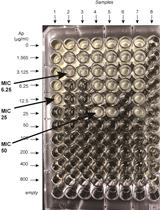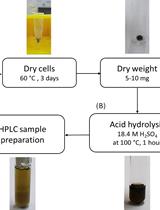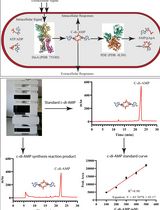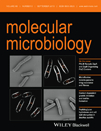- Submit a Protocol
- Receive Our Alerts
- Log in
- /
- Sign up
- My Bio Page
- Edit My Profile
- Change Password
- Log Out
- EN
- EN - English
- CN - 中文
- Protocols
- Articles and Issues
- For Authors
- About
- Become a Reviewer
- EN - English
- CN - 中文
- Home
- Protocols
- Articles and Issues
- For Authors
- About
- Become a Reviewer
Determination of Oxygen Respiration Rates in Wetted Developmentally Arrested Spores of Streptomyces Species
Published: Vol 4, Iss 12, Jun 20, 2014 DOI: 10.21769/BioProtoc.1153 Views: 8999
Reviewed by: Anonymous reviewer(s)

Protocol Collections
Comprehensive collections of detailed, peer-reviewed protocols focusing on specific topics
Related protocols

β-lactamase (Bla) Reporter-based System to Study Flagellar Type 3 Secretion in Salmonella
Fabienne F. V. Chevance and Kelly T. Hughes
Jun 20, 2023 1606 Views

Determination of Poly(3-hydroxybutyrate) Content in Cyanobacterium Synechocystis sp. PCC 6803 Using Acid Hydrolysis Followed by High-performance Liquid Chromatography
Janine Kaewbai-ngam [...] Tanakarn Monshupanee
Aug 20, 2023 1646 Views

An HPLC-based Assay to Study the Activity of Cyclic Diadenosine Monophosphate (C-di-AMP) Synthase DisA from Mycobacterium smegmatis
Avisek Mahapa [...] Dipankar Chatterji
Dec 20, 2024 1604 Views
Abstract
Streptomyces species produce spores, which, while not as robust as endospores of Bacillus or Clostridium species, are capable of surviving for months or even years (Hopwood, 2006). During this time these spores remain viable, surviving by slowly degrading internal stores of carbon compounds, such as the carbohydrate trehalose. To enable metabolism to continue they must have access to an electron acceptor that allows the removal of the reducing equivalents that accumulate through metabolic activity. The most commonly used acceptor is oxygen. We describe the quantitative measurement of oxygen respiration rates by developmentally arrested spores of the streptomycete Streptomyces coelicolor (Fischer et al., 2013).
Keywords: Cytochrome oxidaseMaterials and Reagents
- Freshly harvested Streptomyces spores in water
- Soya flour (from local supermarket)
- D-mannitol (Sigma-Aldrich, catalog number: 63560 )
- Agar-agar (Kobe I) (Roth North America)
- 3-(N-morpholino) propanesulfonic acid (MOPS) buffer (Roth North America)
- Chloramphenicol (Merck KGaA)
- Sodium hydroxide pellets (Roth North America)
- MOPS-buffer (see Recipes)
- SFM agar (see Recipes)
Equipment
- Cotton wool (standard issue from local Pharmacy) for spore preparation
- 0.22 µm pore-size filters (PVDF) (Sartorius AG)
- 30 °C rotary shaker
- Baffled Erlenmeyer flasks (500 ml) (Glasgerätebau Ochs, Laborfachhandel e. K., catalog number: 100500 )
- Standard-sized plastic Petri dishes for bacterial growth and spore preparation
- Gas-tight glass Hungate tubes (16 ml) for anaerobic work with butyl rubber septa (Glasgerätebau Ochs, Laborfachhandel e. K., catalog number: 1020471 )
- Cooled table-top centrifuge (e.g. Eppendorf)
- Needles (0.6 mm gauge) (B. Braun Melsungen AG)
- Water bath or heating block (Biometra)
- Spectrophotometer capable of measuring absorption in the visible range
- Optical ‘FirestingO2 oxygen meter’ (Pyro Science GmbH)
- Contactless optical oxygen ‘sensor spot’ (Pyro Science GmbH)
- ‘Bare fibre’ (Pyro Science GmbH)
- Adjustable mini magnetic stirrer (e.g. IKA) (10 mm x 0.3 mm magnetic stirrer bar) (e.g. Roth North America)
Software
- Firesting Logger Software (Pyro Science GmbH)
Procedure
- Streptomyces coelicolor was grown on SFM agar plates at 30 °C until colonies sporulated (Kieser et al., 2000). Spores were isolated by using cotton swabs and were washed with water and filtered twice through cotton wool (Kieser et al., 2000). Subsequently they were adjusted to an OD450nm of 10 or 20 (1 ml of an OD450 = 1 is equivalent to 3.5 x 108 spores ml−1 or 2.37 x 108 cfu.).
- The oxygen reduction rate by spores was measured in 16 ml gas tight Hungate vials in a 30 °C room or chamber.
- The vials were filled with 5 ml of 50 mM MOPS buffer (pH 7.2), containing chloramphenicol (400 μg ml−1) and spore suspension with an OD450nm of 25 (Fischer et al., 2013).
- The spore suspension was stirred continuously with a magnetic stirrer at 800 rpm upto an oxygen saturation in the spore suspension. Oxygen saturation was determined empirically for each experiment performed and this process generally took approximately 2 min based on a stirring speed of 800 rpm. The vials were closed with a gas-tight rubber plug and simultaneously the pressure was equalized with a needle one time and the on-line measurement cycle was initiated, exactly as indicated in the protocol delivered by the manufacturer. An image of the experimental setup is available at http://www.pyro-science.com/optical_oxygen_meter_firesting_O2.html.
- The oxygen level in the remaining 11 ml headspace was monitored non-invasively and continuously over a period of 15 h using the oxygen-measuring system of Pyro Science GmbH and documented using the Firesting Logger Software. To do this, oxygen-dependent luminescence sensor spots were affixed to the glass wall of the tube within the headspace and the signals were measured through the vial’s glass wall using an optical oxygen meter (FirestingO2).
- The oxygen respiration rate was calculated as the moles of oxygen reduced per volume oxygen in the headspace with respect to the dry weight of spores (1 OD ml−1 = 0.12 mg dry weight). A representative example of data is shown in Fischer et al. (2013).
Recipes
- MOPS-buffer
Adjusted to pH 7.2 with NaOH
Sterilized by filtration through 0.22 µm filter
- SFM agar
20 g L−1 soya flour
20 g L−1 D-mannitol
Agar-agar (Kobe I)
Acknowledgments
This work was supported by the Deutsche Forschungsgemeinschaft (SA 494/4-1).
References
- Fischer, M., Falke, D. and Sawers, R. G. (2013). A respiratory nitrate reductase active exclusively in resting spores of the obligate aerobe Streptomyces coelicolor A3(2). Mol Microbiol 89(6): 1259-1273.
- Hopwood, D. A. (2006). Soil to genomics: the Streptomyces chromosome. Annu Rev Genet 40: 1-23.
- Kieser, T., Bibb, M. J., Buttner, M. J., Chater, K. F. and Hopwood, D. A. (2000). Practical Streptomyces Genetics. Norwich: The John Innes Foundation.
Article Information
Copyright
© 2014 The Authors; exclusive licensee Bio-protocol LLC.
How to cite
Fischer, M., Falke, D. and Sawers, R. G. (2014). Determination of Oxygen Respiration Rates in Wetted Developmentally Arrested Spores of Streptomyces Species. Bio-protocol 4(12): e1153. DOI: 10.21769/BioProtoc.1153.
Category
Microbiology > Microbial biochemistry > Other compound
Microbiology > Microbial metabolism > Nutrient transport
Do you have any questions about this protocol?
Post your question to gather feedback from the community. We will also invite the authors of this article to respond.
Tips for asking effective questions
+ Description
Write a detailed description. Include all information that will help others answer your question including experimental processes, conditions, and relevant images.
Share
Bluesky
X
Copy link











